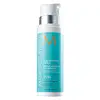What's inside
What's inside
 Benefits
Benefits

 Concerns
Concerns

 Ingredients Side-by-side
Ingredients Side-by-side

Water
Skin ConditioningCetyl Alcohol
EmollientBehentrimonium Chloride
PreservativeStearyl Alcohol
EmollientCetrimonium Chloride
AntimicrobialGlycerin
HumectantIsopropyl Alcohol
SolventHydroxyethylcellulose
Emulsion StabilisingHydrolyzed Soy Protein
HumectantHydrolyzed Rice Protein
Skin ConditioningPersea Gratissima Oil
Skin ConditioningButyrospermum Parkii Butter
Skin ConditioningGlycine Soja Oil
EmollientCaprylic/Capric Triglyceride
MaskingTetrasodium EDTA
Dimethicone
EmollientCitric Acid
BufferingParfum
MaskingPhenoxyethanol
PreservativeEthylhexylglycerin
Skin ConditioningCitral
PerfumingLimonene
PerfumingWater, Cetyl Alcohol, Behentrimonium Chloride, Stearyl Alcohol, Cetrimonium Chloride, Glycerin, Isopropyl Alcohol, Hydroxyethylcellulose, Hydrolyzed Soy Protein, Hydrolyzed Rice Protein, Persea Gratissima Oil, Butyrospermum Parkii Butter, Glycine Soja Oil, Caprylic/Capric Triglyceride, Tetrasodium EDTA, Dimethicone, Citric Acid, Parfum, Phenoxyethanol, Ethylhexylglycerin, Citral, Limonene
Water
Skin ConditioningCetearyl Alcohol
EmollientGlycol Stearate
EmollientCetyl Alcohol
EmollientParfum
MaskingDimethicone
EmollientBehentrimonium Methosulfate
Ceteareth-20
CleansingArgania Spinosa Kernel Oil
EmollientHydrolyzed Vegetable Protein Pg-Propyl Silanetriol
Skin ConditioningPPG-1 Trideceth-6
Skin ConditioningPolyquaternium-11
Polyquaternium-37
Polyquaternium-72
Propylene Glycol Dicaprylate/Dicaprate
EmollientButylene Glycol
HumectantCaprylyl Glycol
EmollientC10-40 Isoalkylamidopropylethyldimonium Ethosulfate
Disodium EDTA
Sodium Chloride
MaskingPotassium Sorbate
PreservativeChlorphenesin
AntimicrobialPhenoxyethanol
PreservativeEugenol
PerfumingAlpha-Isomethyl Ionone
PerfumingButylphenyl Methylpropional
PerfumingLinalool
PerfumingHydroxyisohexyl 3-Cyclohexene Carboxaldehyde
MaskingWater, Cetearyl Alcohol, Glycol Stearate, Cetyl Alcohol, Parfum, Dimethicone, Behentrimonium Methosulfate, Ceteareth-20, Argania Spinosa Kernel Oil, Hydrolyzed Vegetable Protein Pg-Propyl Silanetriol, PPG-1 Trideceth-6, Polyquaternium-11, Polyquaternium-37, Polyquaternium-72, Propylene Glycol Dicaprylate/Dicaprate, Butylene Glycol, Caprylyl Glycol, C10-40 Isoalkylamidopropylethyldimonium Ethosulfate, Disodium EDTA, Sodium Chloride, Potassium Sorbate, Chlorphenesin, Phenoxyethanol, Eugenol, Alpha-Isomethyl Ionone, Butylphenyl Methylpropional, Linalool, Hydroxyisohexyl 3-Cyclohexene Carboxaldehyde
Ingredients Explained
These ingredients are found in both products.
Ingredients higher up in an ingredient list are typically present in a larger amount.
Cetyl Alcohol is a fatty alcohol. Fatty Alcohols are most often used as an emollient or to thicken a product.
Its main roles are:
Though it has "alcohol" in the name, it is not related to denatured alcohol or ethyl alcohol.
The FDA allows products labeled "alcohol-free" to have fatty alcohols.
Learn more about Cetyl AlcoholDimethicone is a type of synthetic silicone created from natural materials such as quartz.
What it does:
Dimethicone comes in different viscosities:
Depending on the viscosity, dimethicone has different properties.
Ingredients lists don't always show which type is used, so we recommend reaching out to the brand if you have questions about the viscosity.
This ingredient is unlikely to cause irritation because it does not get absorbed into skin. However, people with silicone allergies should be careful about using this ingredient.
Note: Dimethicone may contribute to pilling. This is because it is not oil or water soluble, so pilling may occur when layered with products. When mixed with heavy oils in a formula, the outcome is also quite greasy.
Learn more about DimethiconeParfum is a catch-all term for an ingredient or more that is used to give a scent to products.
Also called "fragrance", this ingredient can be a blend of hundreds of chemicals or plant oils. This means every product with "fragrance" or "parfum" in the ingredients list is a different mixture.
For instance, Habanolide is a proprietary trade name for a specific aroma chemical. When used as a fragrance ingredient in cosmetics, most aroma chemicals fall under the broad labeling category of “FRAGRANCE” or “PARFUM” according to EU and US regulations.
The term 'parfum' or 'fragrance' is not regulated in many countries. In many cases, it is up to the brand to define this term.
For instance, many brands choose to label themselves as "fragrance-free" because they are not using synthetic fragrances. However, their products may still contain ingredients such as essential oils that are considered a fragrance by INCI standards.
One example is Calendula flower extract. Calendula is an essential oil that still imparts a scent or 'fragrance'.
Depending on the blend, the ingredients in the mixture can cause allergies and sensitivities on the skin. Some ingredients that are known EU allergens include linalool and citronellol.
Parfum can also be used to mask or cover an unpleasant scent.
The bottom line is: not all fragrances/parfum/ingredients are created equally. If you are worried about fragrances, we recommend taking a closer look at an ingredient. And of course, we always recommend speaking with a professional.
Learn more about ParfumPhenoxyethanol is a preservative that has germicide, antimicrobial, and aromatic properties. Studies show that phenoxyethanol can prevent microbial growth. By itself, it has a scent that is similar to that of a rose.
It's often used in formulations along with Caprylyl Glycol to preserve the shelf life of products.
Water. It's the most common cosmetic ingredient of all. You'll usually see it at the top of ingredient lists, meaning that it makes up the largest part of the product.
So why is it so popular? Water most often acts as a solvent - this means that it helps dissolve other ingredients into the formulation.
You'll also recognize water as that liquid we all need to stay alive. If you see this, drink a glass of water. Stay hydrated!
Learn more about Water